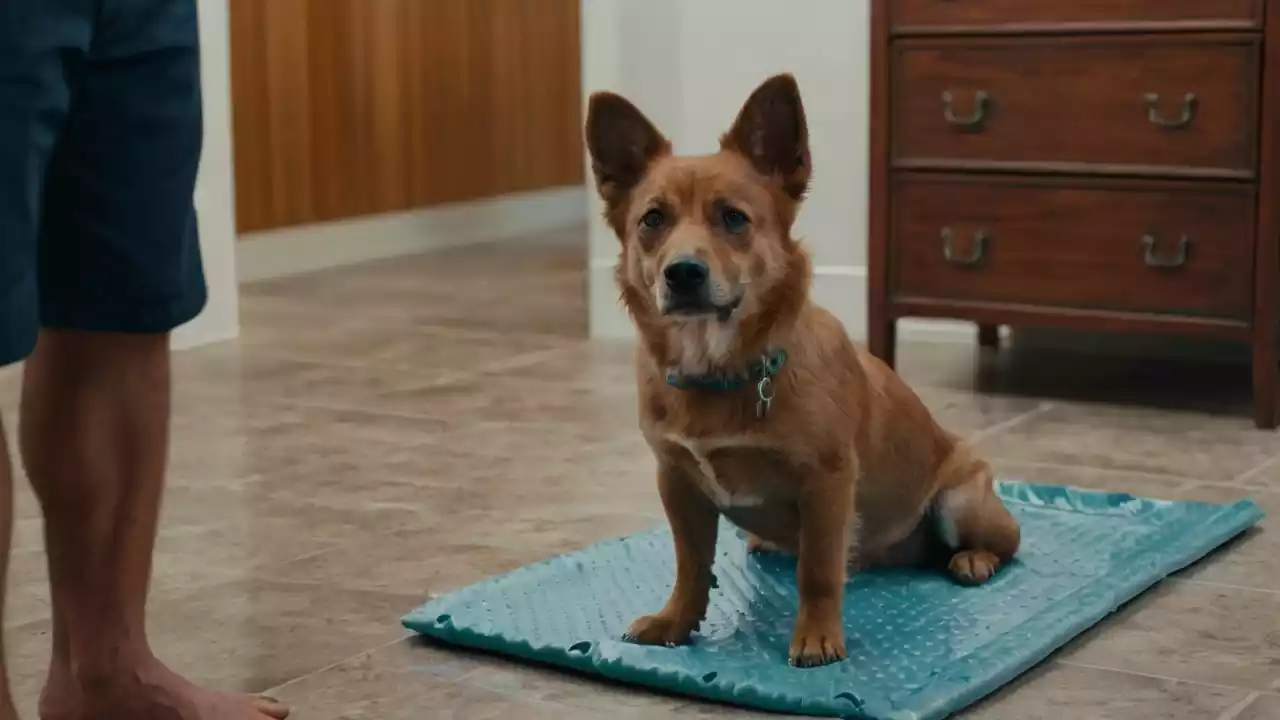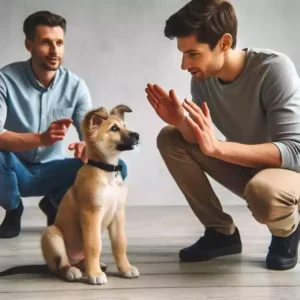
Are you struggling with the challenge of how to train older dog to use pee pad? It can be a heart-wrenching experience to see your beloved senior dog facing difficulties with their bathroom habits, but rest assured, there’s hope and a practical solution. Training an older dog to use a pee pad may seem daunting, but with patience and the right approach, you can make this transition smoother for both you and your furry friend. Let’s explore how to turn this challenge into an opportunity for greater comfort and ease for your cherished companion.
As our beloved dogs get older, they might face challenges like incontinence or trouble with their bathroom routine. But, don’t worry – with patience and the right steps, you can teach your senior dog to use a pee pad. This easy solution offers convenience, hygiene, and comfort for you and your furry friend. We’ll guide you through simple steps to make your older dog feel confident and comfortable with a potty pad.
Switching an elderly dog to a pee pad can really help, especially if they have trouble going outside due to health or mobility issues. By setting up an indoor potty spot, you support your senior dog’s dignity and cleanliness. With the right training and pee pads, your beloved pet can feel secure and comfy in their golden years.
Key Takeaways
- Pee pads with DrySpeed™ Technology and Super Absorbent Polymers (SAP) can instantly turn urine into gel, providing superior absorbency and odor control
- Consider factors like convenience, absorbency, and hygiene when choosing between disposable and reusable pee pads
- Reusable pads offer an eco-friendly option with potential long-term cost savings
- Establish a consistent bathroom break schedule, especially for senior dogs who may need more frequent trips
- Use positive reinforcement, such as treats and verbal cues, to encourage successful pee pad training
Why Pee Pads are Useful for Senior Dogs
As our dogs get older, they may have health issues and trouble moving around. This makes it hard for them to go outside often to pee. Pee pads, both disposable and reusable, can help senior dog owners a lot.
Limited Mobility and Health Issues
Old or disabled dogs often have trouble with arthritis, less energy, and other health problems. These issues make it hard for them to go outside and find a spot to pee. Using pee pads for indoor potty training can change everything. It lets these senior dogs go to the bathroom safely at home.
Convenience for Apartment Living or Reduced Mobility of Owner
For pet owners in high-rise buildings or with limited mobility, taking their senior dogs out can be tough. Pee pads offer a handy indoor solution. They mean no more frequent trips outside, making life easier for dogs and owners alike.
Some senior dogs may not know where to pee in new places. Pee pads can be a good choice. They help these dogs feel safe and sure about going to the bathroom.
Adding pee pads to a senior dog’s routine can make their life easier. It ensures they have a comfy way to go to the bathroom indoors. This brings peace of mind to pet owners.
“Pee pads can be a game-changer for senior dogs, allowing them to relieve themselves comfortably within the safety and familiarity of their own homes.”
Choosing the Right Pee Pads for Your Senior Dog

Choosing the right indoor dog potty solution for your senior pup is key. Disposable pee pads are easy to use and absorb well, making them a top choice for older dogs4. Reusable pads are better for the planet and save money over time.
Disposable vs. Reusable Pee Pads
Disposable pee pads are made for one-time use, offering a clean and easy way to handle accidents from senior dogs. Reusable pads, however, can be washed and used many times, which is better for the environment.
Factors to Consider: Absorbency, Odor Control, and Size
When picking pee pads for your senior dog, think about absorbency, odor control, and size. Choose pads with strong materials, washable fabrics, fun features, and technology to stop leaks. The pad should be the right size for your dog, big enough to cover the area without being too big.
For a long-lasting, washable, and packed-with-features option, check out the Pet Parents® Pawtect® Pads. These pads have a StickyPaw™ feature and WickQuick® technology to keep liquids in and prevent spills, perfect for training senior dogs.
The best pee pads for your senior dog depend on what you need and like. Take time to look at your options and pick a solution that offers the best mix of features, ease, and value for your pet.
Introducing Your Dog to the Pee Pad

Starting to house train your senior dog with a pee pad means making them feel okay with it. Put the pee pad where your dog usually goes to the bathroom. Let them sniff, paw, and check it out at their own speed. This helps your senior dog get used to the pee pad and link it with going to the bathroom.
Be patient and let your dog get to know the pee pad by themselves. Don’t force them onto the pad or try to make them go, as this can make things harder. Give them treats and praise when they show interest or touch the pad.
When your senior dog seems okay with the pee pad, start guiding them to use it. Take them to the pad at their usual potty times, like after meals or when they wake up. Give them treats and lots of praise when they go on the pad. This will teach them that using the pee pad is a good thing.
Training an older dog to use a pee pad might take longer than with a puppy. Being consistent and using positive rewards is important. With patience and effort, your senior dog will learn to use the pee pad easily.
Designating a Potty Area

Training your senior dog to use a pee pad means picking a special spot in your home. This spot should be easy for your dog to get to but not near where they sleep or eat. Using a bit of your dog’s urine on the pad helps them know it’s their spot.
Choose a quiet spot for your dog to go potty. Putting the pee pad in a corner or near the door can make it more appealing. This is great for older dogs that can’t move easily or live in apartments.
Being consistent is crucial for training older dogs. Stick to a routine and reward your dog for using the pee pad. With time and effort, your senior dog will learn to go to their special spot.
| Factors to Consider | Disposable Pee Pads | Reusable Pee Pads |
|---|---|---|
| Absorbency | Multi-layer design for extra absorbency, some with Super Absorbent Polymers (SAP)9 | Machine-washable for easy cleanup9 |
| Environmentally Friendly | – | More eco-friendly option9 |
| Cost-Effectiveness | – | Can save money in the long run9 |
Choosing a specific spot for your senior dog helps them feel secure and confident. The right spot and a consistent routine make pee pad training work for your aging dog.
Establishing a Consistent Routine

House training an older dog to use a pee pad is all about being consistent and sticking to a routine. Senior dogs often need to go outside more often than younger dogs. Training an older dog takes longer than a puppy, so being patient and consistent is crucial. Older dogs might take more time to learn new habits.
Frequent Bathroom Breaks for Senior Dogs
Keep a regular schedule for your dog’s bathroom breaks and always take them to the pee pad area at the same times. This helps your senior dog learn the routine and avoid accidents. If your dog has health issues like incontinence or bladder infections, seeing a vet is a must.
Supervision and Redirection
Watching your dog closely during training is very important. If you see your pet starting to have an accident, guide them to the pee pad area. This way, your senior dog will learn where to go. If you can’t watch your dog all the time, think about using a playpen with a pee pad to catch any accidents.
With a consistent routine and close supervision, you can help your older dog learn to use a pee pad. Remember, patience and persistence are important during this training.
Using Positive Reinforcement
Training your senior dog to use a pee pad is all about positive reinforcement. When they go in the right spot, give them lots of praise and a yummy treat right away. This makes them want to do it again.
Using words like “potty” or “pee” can help your dog learn faster. Say these words every time you’re training, so they know what you mean.
If your dog tries to go somewhere else, gently move them to the pee pad. With time and patience, they’ll learn the pee pad is where they should go.
Senior dogs might need more time to learn new things, but they can do it with your help. By rewarding them for doing the right thing, you make them feel good about it. This makes them more likely to stick with their new potty routine.
How to Train Older Dog to Use Pee Pad

Training your senior dog to use a pee pad can be a gentle and patient process. Older dogs may not be used to these indoor potty solutions. So, it’s key to understand their needs. If your senior pet has an accident, don’t scold or punish them. Clean up quickly with an enzymatic cleaner to remove smells that might make them go there again.
Gentle Guidance and Patience
Training an older dog to use a pee pad takes time. Be patient and praise your senior pet when they use the potty area right. Positive reinforcement is key to encouraging good behavior.
Proper Cleaning for Accidents
Accidents will happen during training, but handle them right. Don’t use ammonia-based cleaners, as they might make your dog think that area is good for peeing. Choose pet-safe enzymatic cleaners instead. They remove odors and help prevent more accidents.
Learning to use pee pads is a big help for older dogs, especially those with health issues. With patience and understanding, you can help your senior dog get used to this indoor potty solution.
“It’s important to remember that training an older dog to use a pee pad takes time and commitment, but the rewards of a clean, comfortable home and a happy, healthy pet are well worth the effort.”
Tips for Successful Pee Pad Training

To make pee pad training work for your senior dog, stick to a regular feeding schedule. This helps your dog get used to a set potty schedule. Also, use enzyme-based cleaners to get rid of any smells. This stops your dog from going back to the same spot, helping them learn the right spot.
Training an older dog needs patience and understanding. Don’t scold your dog for accidents as it can make them more stressed. Instead, reward them with praise and treats when they use the pee pad correctly. With patience and consistency, your senior dog will learn the pee pad is where they should go.
Scheduled Feedings for Better Potty Routine
Having a regular feeding schedule helps your senior dog’s potty training. Linking meal times with potty breaks helps your dog have a regular pattern. This makes training easier and more effective.
Enzyme-Based Cleaners for Odor Elimination
Dealing with smells is a big challenge in training senior dogs for pee pads. Use enzyme-based cleaners to get rid of these smells. These products break down the smell-causing compounds, keeping your dog away from the same spot.
🚀 Transform Your Dog’s Behavior with Brain Training for Dogs!
Struggling with your older dog’s potty training or other behavioral issues? Adrienne Farricelli’s Brain Training for Dogs is the proven solution you need! This CPDT-KA certified program unlocks your dog’s hidden intelligence to eliminate bad habits and create a well-behaved, obedient companion.
Why This Program Works:
✔ Science-Based Training: Uses neuroplasticity to rewire your dog’s brain for better behavior.
✔ Force-Free Methods: Gentle, positive techniques—no dominance or punishment.
✔ Step-by-Step Games: Over 21 fun, mentally stimulating activities to curb bad habits.
✔ Tailored Solutions: Addresses root causes of barking, chewing, leash-pulling, and more.
✔ Certified Expertise: Created by a professional trainer with 10+ years of experience.
🎁 Bonus: Get Behavior Training for Dogs FREE—a guide to stopping whining, digging, and other common issues!
💡 Limited-Time Offer: Only 67(Originally67(Originally127)!
👉 Click Here to Access Brain Training for Dogs RISK-FREE Now!
60-day money-back guarantee—no questions asked! Don’t wait—give your dog the gift of obedience today! 🐾
Conclusion
Training your senior dog to use a pee pad can be a big help for you and your pet. It might take some time, but you and your older dog can do it together. Pick the right pee pad, stick to a schedule, and use positive reinforcement to make it easy for your aging dog.
Senior dogs might have challenges like less mobility, health issues, or changes in their routine that affect their potty training. Being patient, understanding, and taking a tailored approach is crucial for your older dog to learn using pee pads. With commitment and the right methods, you can make a positive and stress-free space for your senior dog to feel secure in their indoor potty habits.
The journey of pee pad training for your senior dog might have its ups and downs, but the benefits are huge. By offering a convenient and easy solution, you keep your aging pet comfortable and keep your home clean and healthy. Embrace the journey, and enjoy the peace of mind that comes with helping your senior dog through this big change.
FAQ
What are the benefits of using pee pads for senior dogs?
Senior or disabled adult dogs may find it hard to pee outside. Pee pads can be a good solution, especially for owners who have trouble taking their dogs out. They’re also useful for dogs living in high-rise buildings or new areas, helping them know where to go.
How do I choose the best pee pads for my senior dog?
Look for absorbency, odor control, and size when picking pads. Disposable pads are easy to use and keep things clean. Reusable pads are better for the planet and save money over time.
How do I introduce my senior dog to the pee pad?
Start by placing the pad near where your dog usually goes to the bathroom. Let them sniff and paw at it to get used to it. You can also put a bit of your dog’s urine on the pad to show them it’s for potty time.
Where should I designate the potty area for my senior dog?
Pick a spot in your home for your dog’s pee pad. Make sure it’s easy for them to get to but not near their food or water bowls.
How do I establish a consistent routine for my senior dog’s bathroom breaks?
Senior dogs might need to go more often, so take them to the pee pad spot regularly. Watch for accidents and guide them back to the pad to help them learn.
How can I use positive reinforcement to encourage my senior dog to use the pee pad?
When your dog goes to the bathroom in the right spot, praise them and give a treat. Use commands like “potty” or “pee” to help them connect the action with the command.
What should I do if my senior dog has an accident?
If your senior dog has an accident, don’t scold them. Clean up with a pet-safe cleaner to remove smells. This will help prevent them from going there again.
What other tips can help with successful pee pad training for my senior dog?
Keep a regular feeding schedule to help with potty training. Use enzyme cleaners to get rid of smells, which will keep your dog away from the same spot. Be patient, consistent, and understanding of your dog’s limits during training.






